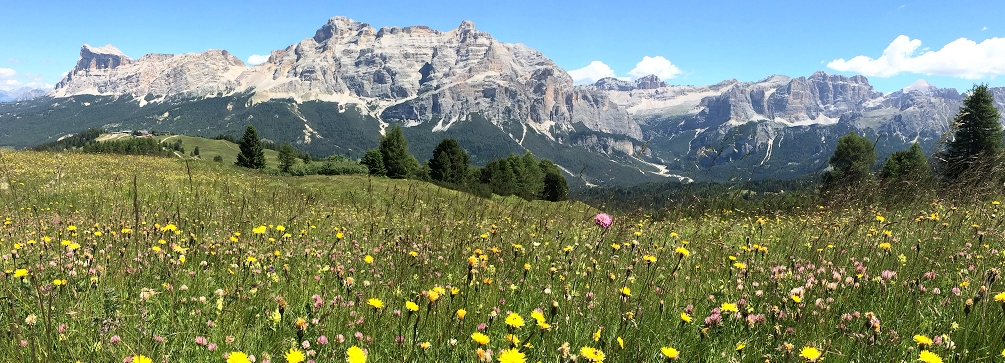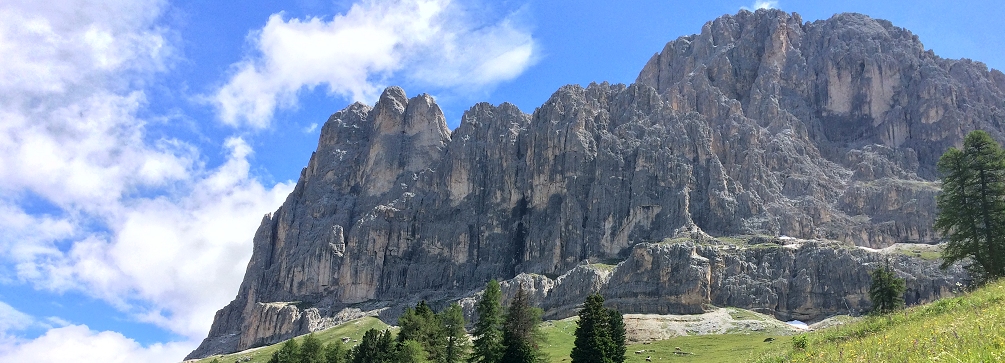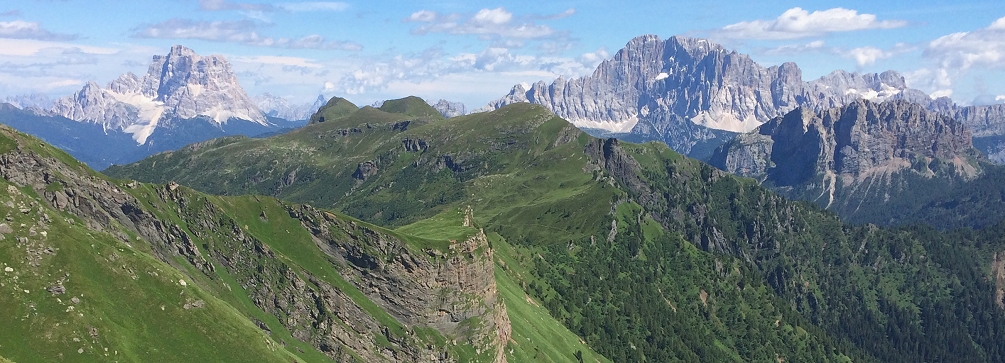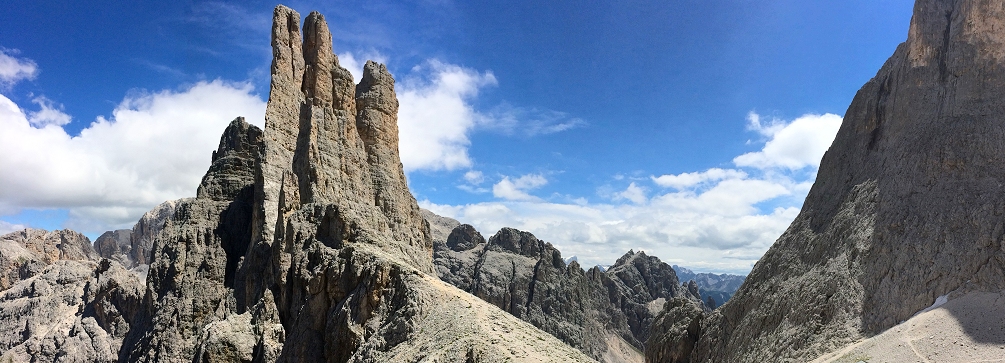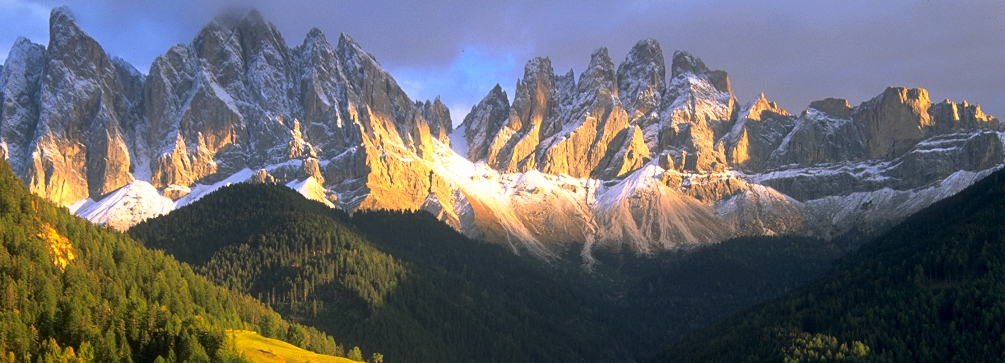Best Hikes in the Dolomites II
Fassa, Fiorentina, Badia & Gardena Valleys

More Hikes in the Dolomites of Italy Slide Show
More Hikes in the Dolomites of Italy Slide Show for iPad and iPhone

Join us during the mountain summer and celebrate the third decade of Mountain Hiking Holidays in the Dolomites, the place where it all began! This version of our popular “Best Hikes in the Dolomites” tours was designed to celebrate the 20th anniversary of Mountain Hiking Holidays in 2016. Co-founders John and Amy Osaki led their first tour through the Dolomites in September of 1995 and four months later established Mountain Hiking Holidays (then known as Walking Softly Adventures). Over the span of two decades and after leading hikes over hundreds of miles of trails in mountains around the world, we find that the Dolomites still hold their own. There is something special and magical about them and they keep drawing us back. Perhaps the old legends of elves spinning moonbeams to lay a luminous cloak over the mountains might be true. These are truly enchanted mountains that will weave their enchantments on you! All those who love mountains should experience the Dolomites at least once.
This tour includes hikes and overnight stays in two “new” valleys (the Val di Fassa and the Val Livinalongo) along with stays in our “old favorites”—the Val Badia and the Val Gardena. The Val di Fassa and the Val Livinalongo are located in the southern portion of the Dolomites. Both valleys are Ladin-speaking with a more Italian flavor as contrasted with the valleys in the northern portions of the Dolomites which are more Germanic in character.
On this trip, you’ll experience all the elements of the Dolomites landscape (named a World Heritage Site in 2009)—skyscraping peaks, flowery meadows, charming villages sporting flower-filled window boxes, an extensive and varied trail system the envy of other mountain ranges, and mountain refuges offering shelter, food and camaraderie.

Ameila Edwards describes a view of Monte Pelmo in the account of her journey through the Dolomites in 1872.

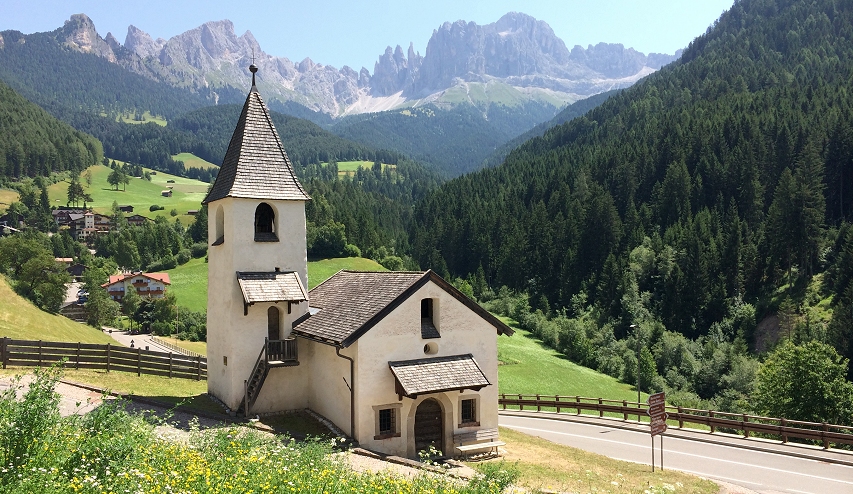
Church of St. Cyprian in the Val di Tires backdropped by the Rosengarten.
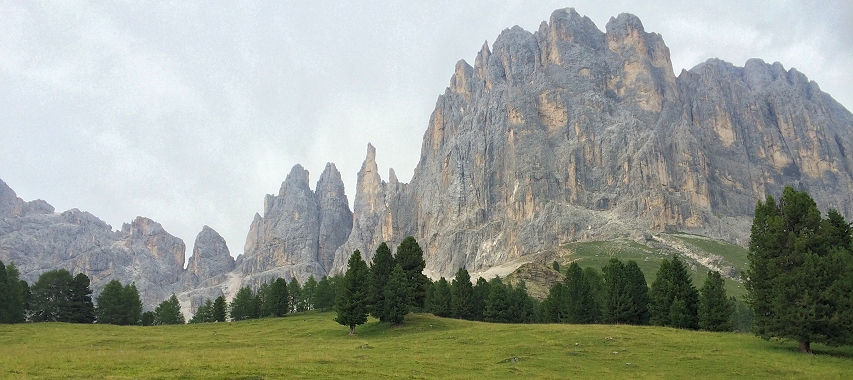
Meadows of the Angelwiesen and the ramparts of the Rosengarten under a lowering sky.
Arrival Day
Overnight in Vigo di Fassa
Dinner included
We will provide one complimentary transfer from Piazza Walther in Bolzano (or the Bolzano train station) to the mountain village of Vigo di Fassa on this day. Planned departure time from Bolzano will be 5:00 PM. Please plan to be in Bolzano by this time. If you would like to spend some time exploring Bolzano (which we highly recommend), we suggest you plan on arriving in Bolzano one or two days before the start of the trip. See About Bolzano.
Day 1
Overnight in Vigo di Fassa
Breakfast included
Travel by vehicle from Vigo di Fassa over the Passo di Costalunga into the Val di Tires (Tiersertal, in German). From the Purgametschtal ascend through cool woodlands to the rustic mountain hut at Hanicker Schwaige, Here, the soaring, slender rock spires of the Torri di Vajolet rise abruptly and form a splendid backdrop. The trail then ascends to the wide open meadows of the Angelwiesen and continues along the base of the Rosengarten (“Rose Garden”) wall before descending to reach the Frommeralm. From Frommeralm, ascend by chairlift to the Rosengarten mountain refuge from where a contouring mountain path known as the Hirzlweg swings around the southern extent of the Rosengarten group of peaks. The path continues to the Rifugio Roda de Vael set in a mountain saddle on the eastern flanks of the Rosengarten. From the refuge the path ascends slightly before contouring along open slopes that offer wonderful views over a sea of peaks. A final descent through woods and meadows brings you to the gondola station at Ciampedie. Descend by gondola (called a “funivia” in Italian) back to Vigo di Fassa. For a less strenuous hike, you can choose to hike only the highly scenic section from the Frommeralm to Ciampedie.
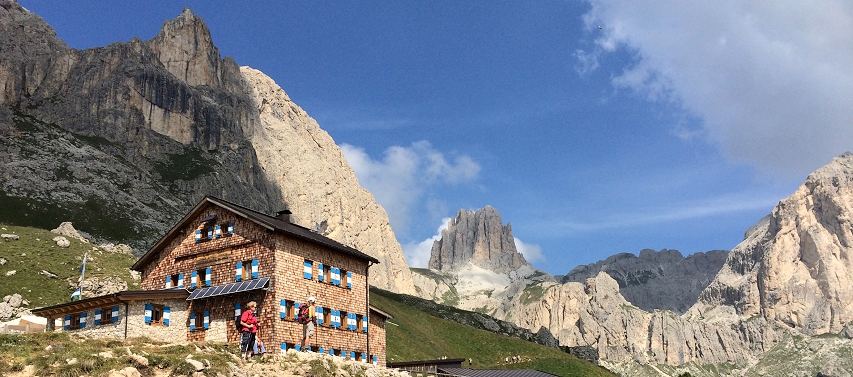
Rifugio Roda di Vael in the Rosengarten group of peaks.

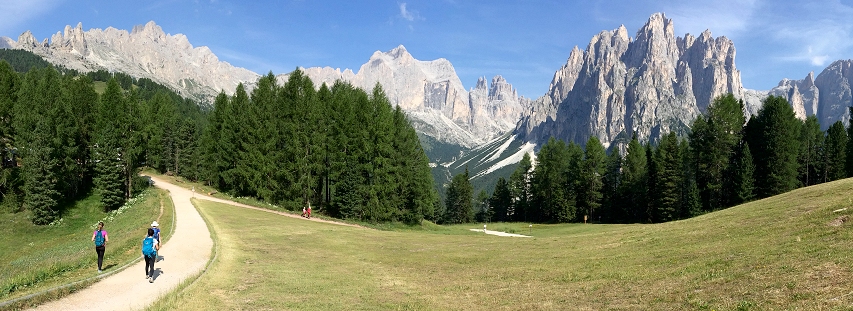
The peaks of the Crepe di Larsech and the Val di Vajolet from Ciampedie.
Day 2
Overnight in Vigo di Fassa
Breakfast and dinner included
Ascend via the Catinaccio funivia to the mountain meadows at Ciampedie. From this high country trailhead, set off on a path that winds through larch woods along the western slopes of the Val di Vajolet to reach the Rifugio Gardeccia set in a subalpine bowl sandwiched between the peaks of the Rosengarten mountain group and the spires of the Crepe di Lasech. From here the broad path ascends steadily but easily through an open, rock-strewn landscape before arriving at the Rifugio Preuss set atop a rocky promontory overlooking the valley. Energetic hikers can continue beyond this point ascending a steep path to the Gartlhütte. Just uphill from the Gartlhütte a rocky saddle provides a dramatic, never-to-be-forgotten view of the rocky Vajolet Towers (Torri di Vajolet) rising abruptly into the alpine sky. A short distance further is the Rifugio Santner from where a grand view over the upper Val di Tires opens up before you. On a clear day, the peaks of the Austrian Alps are also on display. After soaking in the views, retrace your steps to the funivia at Ciampedie and glide back down to the valley floor and your accommodations for the evening.
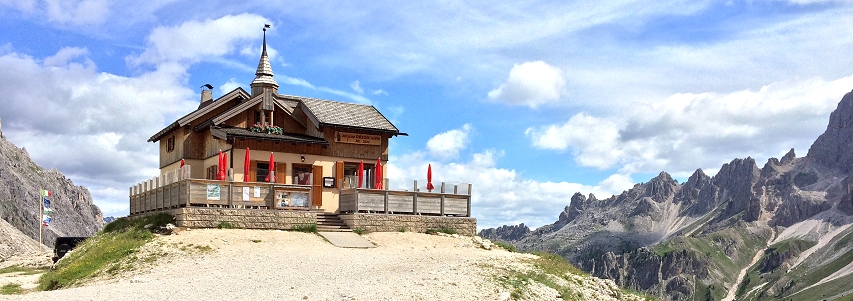
Rifugio Preuss in the Val di Vajolet, Rosengarten.


Hikers on the Bindelweg enjoy stunning views of snow-capped Marmolada.
Day 3
Overnight in Arabba
Breakfast and dinner included
After breakfast, travel by vehicle to the head of the Val di Fassa and the lovely village of Canazei whose name means “cane thicket.” From Canazei, a two-stage gondola lifts you from the valley floor to the Col dei Rossi at the end of a high alpine ridge known as Belvedere. Walk along this open ridge and enjoy glorious views of the Sella mountain group to the north and the mass of the glacier-clad peak of Marmolada (the “Queen of the Dolomites”) to the south. Near the Rifugio Fredarola, intersect the trans-Dolomites hiking route known as the Alta Via 2. Follow the Alta Via 2 as it heads eastward as the Viel del Pan which means “bread road” in Ladin, a Romance language indigenous to the valleys of the Dolomites. This route was once used by flour merchants from Belluno (south of the Dolomites) to transport their wares into the mountains. Follow the Viel del Pan as it descends to the Lago di Fedaia at the northern foot of the Marmolada. For a longer hike, instead of descending to Lago di Fedaia, you can make a quick ascent to the Porta Vescovo where another path continues through the high meadows toward the peak of La Mesolina from where you’ll descend to the Fedaia Pass. At the conclusion of the hikes, travel by vehicle to the small village of Santa Fosca in the Val Fiorentina whose inhabitants speak the “cadorino” form of the Ladin language. Settle in for a two-night stay near the beautiful village of Selva di Cadore. The village church backed by the towering north face of Monte Pelmo forms an indelible Dolomites scene!
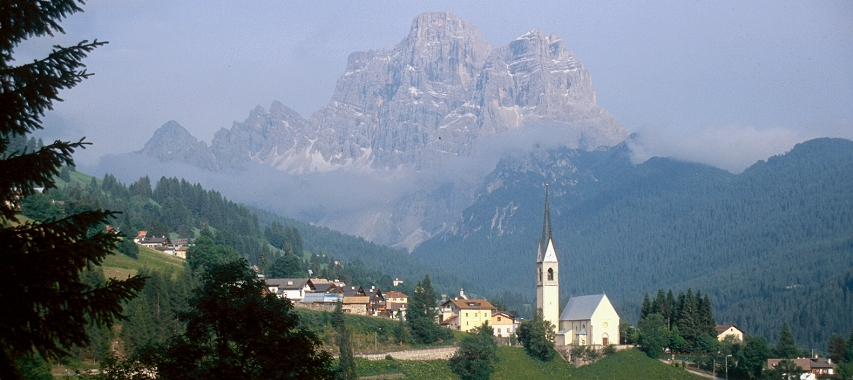
The village of Selva di Cadore in the Val Fiorentina.

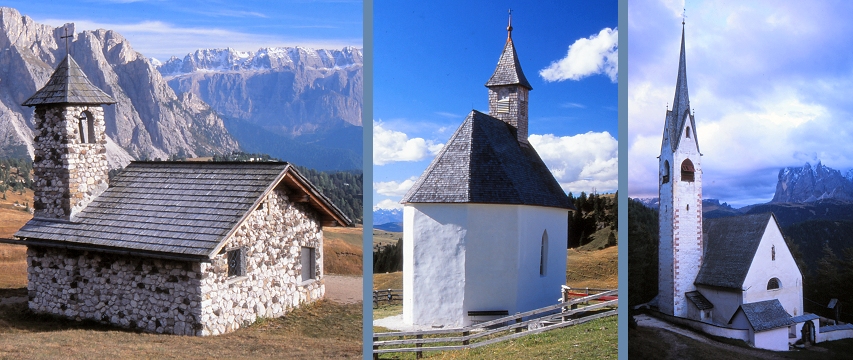
Chapels grace the Alpine landscape throughout the Dolomites.
The Chapels of the Dolomites
It’s almost impossible to hike in the Dolomites without encountering at least one of the lovely chapels that grace the high country throughout these mountains. Why are they here? There are several explanations. In some cases, chapels were erected to commemorate visions, revelations, or locally significant events. An example of the latter are the numerous chapels commemorating events of World War I when the Dolomites were part of the front line between Italy and Austria-Hungary. Earlier, in the mid-seventeenth century, the papal envoy in the Valais region of Switzerland issued a decree against the alpine tradition of celebrating Mass in the open meadows of the mountains, and this may have served to encourage the construction of mountain chapels throughout the Alps. Later, the Romantic movement of the late-eighteenth to nineteenth centuries, which proposed that elements of the sacred were embodied in natural landscapes and features, may also have influenced chapel construction as “temples of people” were raised within the “temple of Nature.” Some chapels were built and maintained as places of private worship. Others became, and continue as, public pilgrimage sites. The origins of other chapels have been lost to time. At any rate, these little chapels remain, for us, testimonies to the faith and perseverance of mountain people. They accentuate the serenity and grandeur of the mountains that surround them. They are gems within the Dolomites landscape and we love them! Above photos, left to right: A stone chapel in the Mastle Alm with the snow-flecked Gruppo Sella in the background; the simple chapel near the Williamshutte; St. Jacob church on the wooded northern slopes of the Val Gardena.

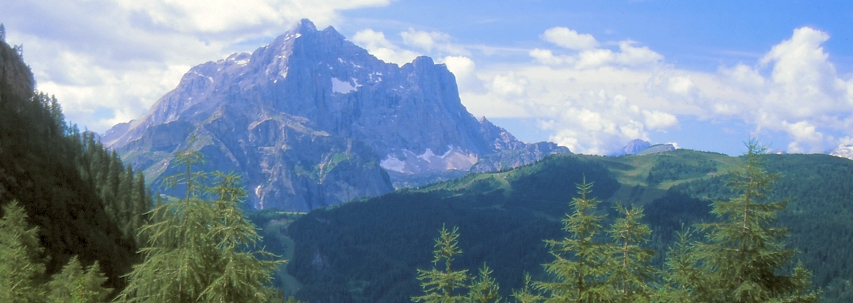
Monte Civetta as seen from the Val Fiorentina.

The hike to Civetta begins near the meadows surrounding the Malga Pioda.
Day 4
Overnight in Arabba
Breakfast and dinner included
Travel by vehicle across the Passo Staulanza and descend into the neighboring Val di Zoldo. Here, the towering masses of Monte Civetta and Monte Pelmo dominate the landscape. Ascend by chairlift into the meadows of Pioda at the northern foot of Civetta. Follow a trail as it leaves the meadows to begin a switchbacking ascent to reach the Rifugio Coldai perched near the lovely turquoise blue lake of the same name. Beyond Lago Coldai, the path now rolls through grassy meadows punctuated with large boulders and clumps of trees. Above you tower the fantastically sheer walls of the north face of Monte Civetta. It’s possible to reach the magnificently-sited Rifugio Attilio Tissi which occupies an exciting perch near the lip of a cliff that drops away to the waters of Lago di Alleghe forty-two hundred feet below. Soak in the far-ranging views before retracing your steps to the top station of the chairlift at Pioda. Descend into the Val di Zoldo by chairlift and travel back to the Val Fiorentina by vehicle.
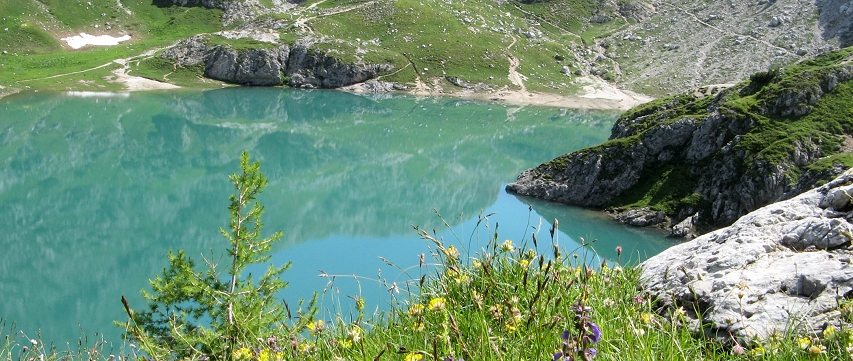
The turquoise waters of Lago Coldai.
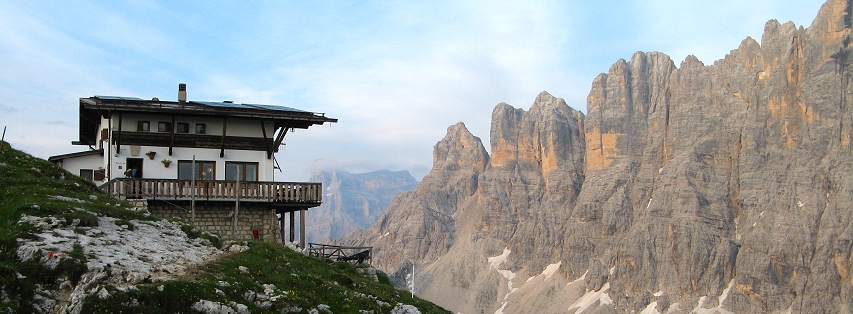
Rifugio Tissi and Monte Civetta’s north face.
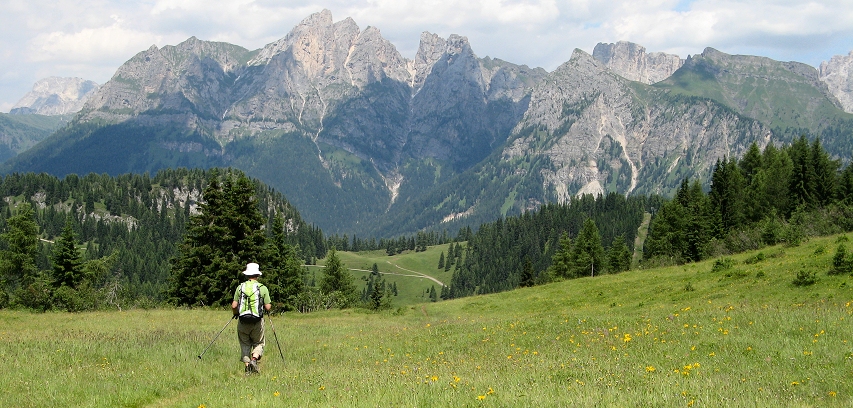
Hiking across the Fertazza plateau.

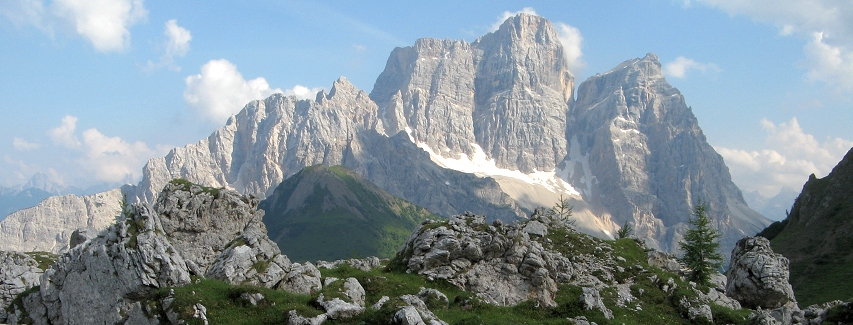
Monte Pelmo from the high ridges above the Val Fiorentina.
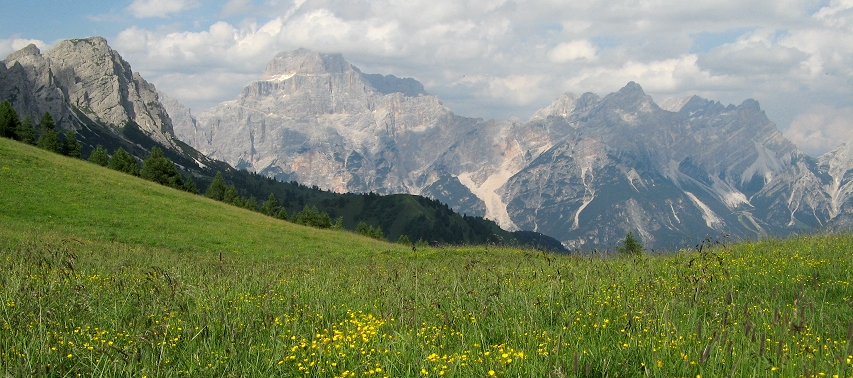
A view of the peak of Antelao from Forcella Roan.
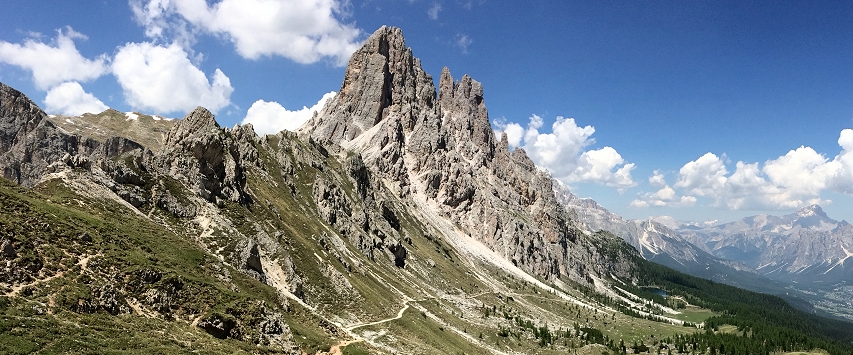
View of the Croda da Lago from Forcella Ambrizzola.
Day 5
Overnight in Colfosco
Breakfast and dinner included
After breakfast, a short vehicle transfer brings you to Passo Staulanza where a path heads along the base of the northern cliffs of Monte Pelmo bound for the Rifugio Citta di Fiume which offers quintessential mountain views to the music of cowbells! The trail then proceeds through meadows and along open ridges to reach the grassy pass known as the Forcella Roan. The route skirts the base of the cliffs on the south side of the Becco di Mezzodi before reaching the Forcella d’Ambrozziola (pass) where you can enjoy a wonderful view of the rocky spine of the Croda da Lago. Amble across the wide meadows of the Mondeval de Sora before making your way to the conclusion of the hike at the Passo Giau. A shorter, alternative hiking option loops around the peak of Nuvolau and takes you on a side trip to the mountaintop Rifugio Nuvolau where 360 degree views abound. At the end of the day’s hikes, travel by vehicle to the village of Colfosco in the upper Val Badia and settle in for a three-night stay.
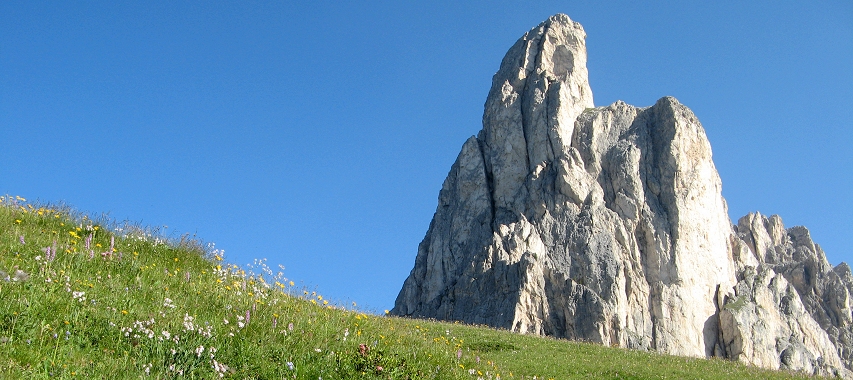
The ramparts of Nuvolau from Passo Giau.
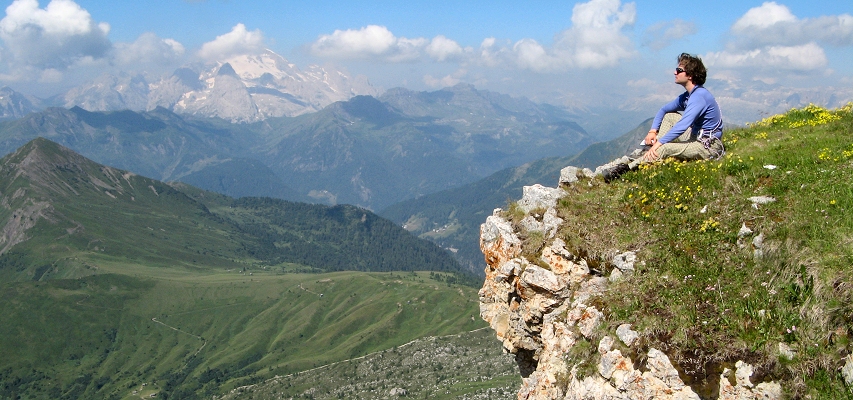
On top of the world at Rifugio Nuvolau.
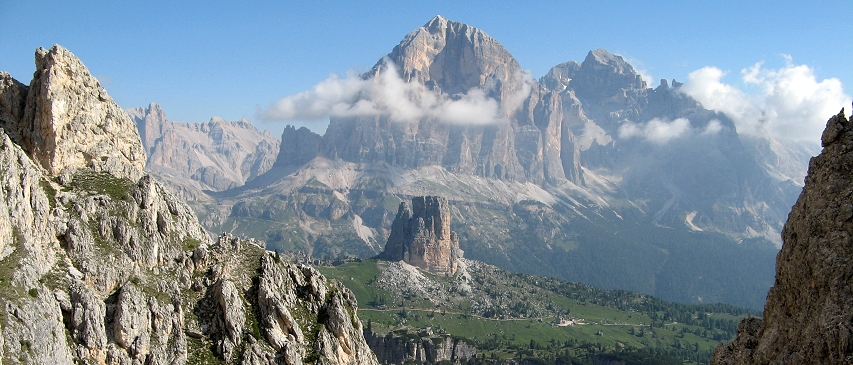
View of Tofane from Nuvolau.

Day 6
Overnight in Colfosco
Breakfast and dinner included
This morning, travel by vehicle to the Passo Campolongo which separates the Sella mountain massif from the meadow-blanketed plateau of Pralongia. At Passo Camplungo, the Cherz chairlift provides access to the southwestern corner of the extensive Pralongia tableland sandwiched between the two forks of the Badia Valley. On the Pralongia plateau (whose elevation averages about 6,500 feet above sea level), mountains surround you on all sides–the Sella and Puez massifs to the west, the Tofane and Fanes to the east, the Marmolada to the south and the peaks on the Italy-Austria border in the distance to the north. From the top of the chairlift, hike through open country to reach the Rifugio Pralongia and its neighboring chapel. The chapel with its wood-shingled roof backdropped by the distinctively-shaped peak of Sassongher makes for a memorable Dolomites view! Continue your hike across the Pralongia heading for Col Alto at the western edge of the plateau. From Col Alto, descend by gondola to the town of Corvara, the principal settlement in the upper Val Badia where the hike concludes. Shuttle by vehicle to the village of Colfosco where you’ll spend the next three nights. If you’re up for a longer hike, you can walk from Corvara all the way to Colfosco via the hamlet of Pescosta nestled at the base of the peak of Sassongher.
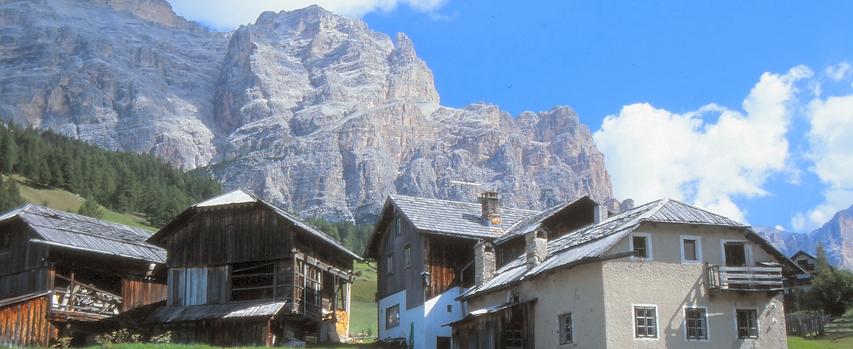
Val Badia scene near San Cassiano.
Day 7
Overnight in Colfosco
Breakfast and dinner included
Transfer by vehicle from Colfosco to the village of Pedraces where a two-stage chairlift will whisk you upslope to the fifteenth century Church of Santa Croce situated at the base of the impressive cliffs of the Sasso della Croce. The adjacent Ospizio di Santa Croce (Hospice of the Holy Cross) has sheltered pilgirms to the site since the early eighteenth century when the church received a relic of the Holy Cross from the Bishop of Bressanone. Enjoy the views of the Val Badia and then begin your hike along a path that contours beneath the orange-tinged walls of the Sasso della Croce. The path will eventually lead you to the lovely village of San Cassiano. For a longer hiking option (time permitting), you can opt for a second hike to the Rifugio Gardenaccia perched on a shoulder of the Puez massif. From the refuge, the views of the Fanes group of peaks, illuminated by afternoon light, are wonderful. Ice-covered Marmolada is also visible in the distance. Transfer by vehicle back to Colfosco for the evening.
SEVEN DAY OPTION CONCLUDES THIS DAY (breakfast and transfer to the rail station at Bressanone the following morning are included).

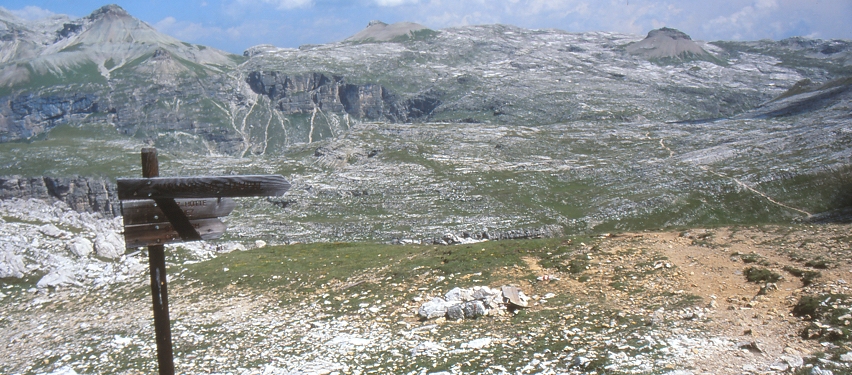
Looking across the Puez plateau toward Rifugio Puez.
Day 8
Overnight in Santa Cristina
Breakfast included
Today, you’ll have an opportunity to travel to the neighboring Val Gardena right to the door of the next hotel using a combination of trails and cable cars. Your luggage will be transported by vehicle. Start the journey with a walk from the hotel to the base station of the two-stage Frara gondola which you’ll use to ascend to the Passo Gardena which separates the Badia from the Gardena valleys. A short walk along the base of the Cir Group of peaks brings you to the top station of the Dantercepies gondola which will lower you into the town of Selva in the Val Gardena. From Selva, you’ll hike to the village of Santa Cristina following the route of the old Val Gardena railway which has been converted to a walking path in a “rails to trails” project. For a more challenging route to Santa Cristina, ascend from Colfosco via gondola to Col Pradat from where a path leads you up the Edelweiss Valley and onto the rocky, limestone plateau of the Puez mountain group. Traverse this almost lunar-like landscape to reach the Rifugio Puez where food and refreshments are available. From Rifugio Puez, the trail descends via switchbacks into the Vallunga (“Long Valley”), a tributary valley of the Val Gardena. On the floor of the Vallunga, hike past the Chapel of St. Sylvester with its 300 year old frescoes revealed during restoration work in 1993. Shortly after that, you’ll reach the old railway route which you’ll follow all the way to Santa Cristina. Settle in for a three-night stay in the Val Gardena.

Rhaetian poppies spring from the rocks.

The Vallunga (“Long Valley”) from the top of the Puez plateau.


Lunch time! Polenta con salsicce e funghi (polenta with sausage and mushroom ragout) at the Rifugio Belvedere.
Rifugio Dining
Having a sit-down lunch at a mountain hut (rifugio) is a quintessential part of a Dolomites experience and one of the great joys of hiking in these mountains. Don’t miss it! Pasta dishes abound including one of our favorites: pasta aglio olio (pasta with garlic and olive oil). Simple, but delicious! Vegetable soup (minestrone) and barley soup (zuppa di orzo) are on the menu at many mountain huts. Hearty fare such as polenta con capriolo e funghi (polenta with roe deer and mushroom ragout) or polenta con salsicce (polenta with sausages) are also typically available. Or, you might order up canederli in brodo (dumplings—sometimes flavored with Tyrolean ham or spinach— in broth). And for dessert? Why, there’s usually always apfelstrudel or strudel di mele (apple strudel) accompanied by an espresso drink or tea. Buon appetito!

And for dessert: Yogurt topped with frutti di bosco (fruits of the forest) served al fresco at a mountain refuge.

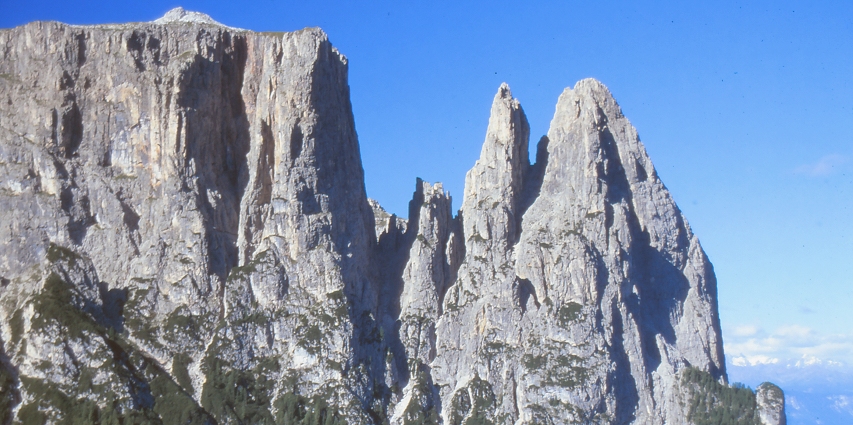
The distinctive form of the Schlern.

The Schlernhute (Rifugio Bolzano) and the peaks of the Rosengarten.
Day 9
Overnight in Santa Cristina
Breakfast and dinner included
Travel by vehicle from the Val Gardena to the village of Seis (Siusi) on the eastern slopes of the Isarco Valley. Here, a cable car will whisk you easily to the Alpe di Siusi, an extensive stretch of alpine meadowland. Ascend to the top of the Puflatschalm (Alpe Bullaccia in Italian), an expanse of rolling meadowland that covers the broad summit of a bulky mountain that lies to the northwest of the Alpe di Siusi. At the western, northern and eastern edges of the Puflatschalm, steep cliffs fall away making the Puflatsch an “island in the sky.” The trail skirts the cliff tops allowing you to enjoy airy views over the lower Val Gardena. Pass over the rocky outcropping known as Hexensessel (“Chair of the Witches”) before turning south to reach the cozy Arnika mountain hut and the path that loops you back to the starting point. For a more challenging hike, follow a switchbacking trail as it ascends the northeastern face of the Schlern, a distinctive flat-topped mountain that hems in the southern edge of the Alpe di Siusi. The trail levels out in the meadows atop the Schlern and soon reaches the rambling Schlernhütte (Rifugio Bolzano) which enjoys a glorious view of the peaks of the Rosengarten group. Return to Santa Cristina for the evening.
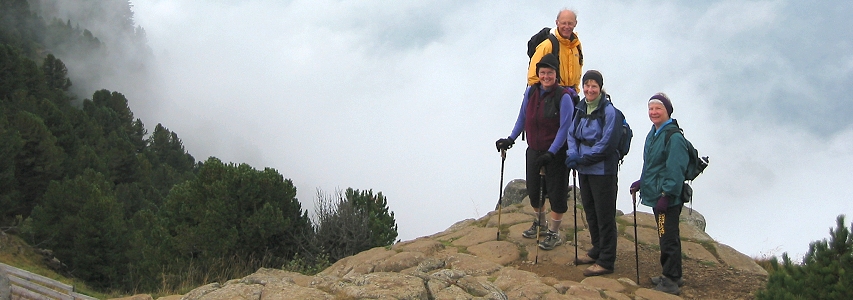
Above the clouds on the Hexensessel (“Chair of the Witches”), Puflatschalm.

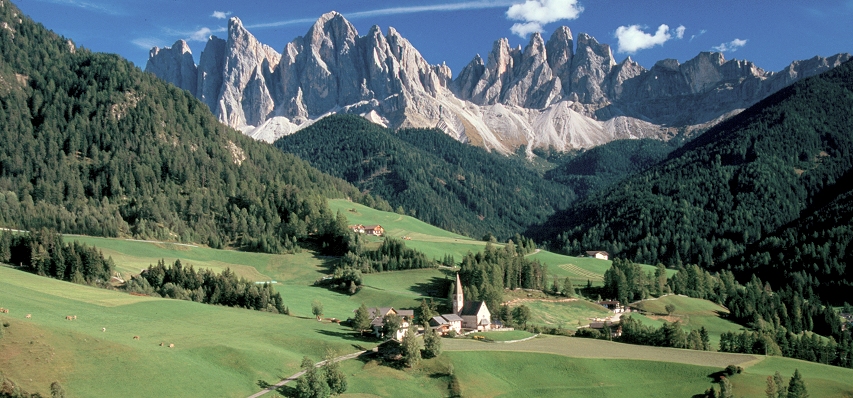
Quintessential Dolomites! The peaks of the Odle Geisler rise at the head of the Val di Funes.
Day 10
Overnight in Santa Cristina
Breakfast and dinner included
From Santa Cristina’s neighboring town, Ortisei, ascend by funicular to the ridgetop meadows of Rasciesa. Follow the trail as it ambles along through open meadows with glorious views of the shark-toothed peaks of the Odle Geisler, the Val Gardena, and the Sella massif. The trail eventually drops gradually to the Rifugio Brogles set in green meadows below the jagged spine of the Geisler peaks. From here you can descend through woods and meadows to the middle station of the Seceda cable car at Furnes. Descend by cable car to the town of Ortisei, the principal settlement in the Val Gardena. If you’re up for a longer hike, continue from the Rifugio Brogles along the path that skirts the base of the Odle Geiser. This path is known as the Adolf Munkelweg (after the founder of the Dresden Alpine Club). The path will lead you to the barely pronounceable Gschnagenhardt Alm, a vast sweep of alpine pastureland backed by the ramparts of the Odle Geisler. Two small rifugi serve food and refreshments in this magnificent setting. Beyond Gschnagenhardt Alm the path leads first to the Glatschalm and then to the Zanser Alm whose flowery meadows are drained by a stream with the tongue-twisting name of Tschantschenonbach. Finish off the day with a short hike in the meadows in the upper Val di Funes where, weather permitting, you’ll enjoy “show-stopping” views that will add a flourish to the conclusion of your Dolomites hiking adventure. Return to Santa Cristina for a farewell dinner. Your breakfast as well as a transfer to the train station in Bressanone are included tomorrow.
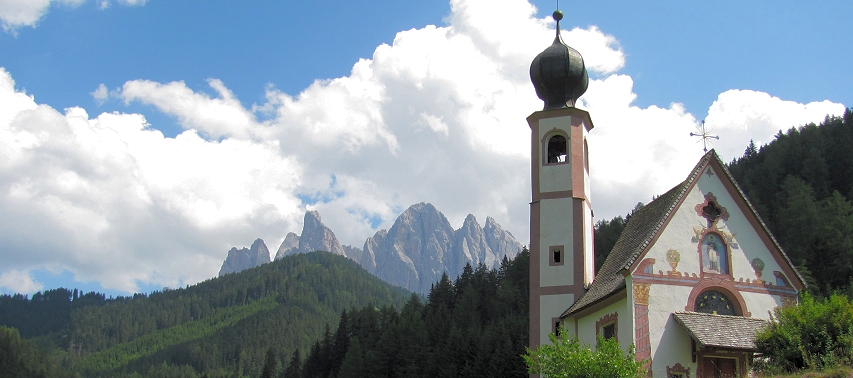
The Chapel of St. Johann in Ranui (1774), Val di Funes.

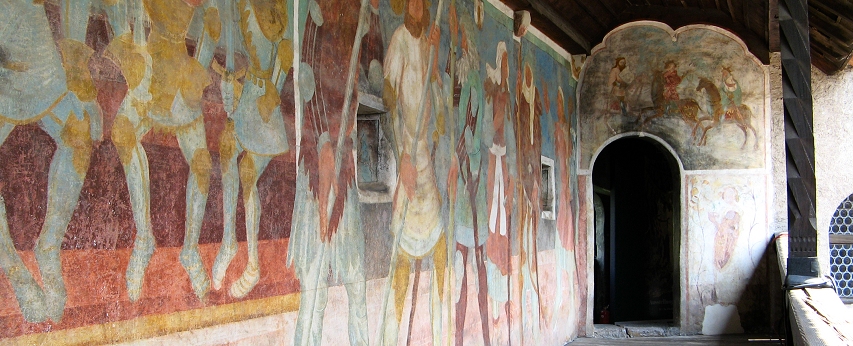
Frescoes at Runkelstein Castle just outside Bolzano. Arrive a day early and enjoy a walk to the castle!
The meeting point for this tour is the city of Bolzano (known as Bozen in German, or Balsan in the indigenous Ladin language). Bolzano is the capital of the Autonomous Province of Bolzano which is also known as Alto Adige in Italian, Südtirol in German, or South Tyrol in English. The city has a distinctly Bavarian flair to it, but most of its inhabitants are Italian-speaking even though most residents of South Tyrol speak German as a first language. Bolzano is a prosperous city and one of the wealthiest regions in the European Union. If you arrive a day or two early, we suggest you check out the South Tyrol Museum of Archaeology which houses the remains of Ötzi (the Iceman) who was found frozen in a glacier in the Ötztal Alps in 1991. Another pleasant excursion is the walk along a tree-shaded promenade to the Runkelstein Castle (Castel Roncolo) which is said to contain the largest cycle of non-religious frescoes in the world. Also worth checking out is the Museion, Bolzano’s museum for modern and contemporary art. For more ideas of things to do in Bolzano, be sure to visit the Bolzano Tourist Office website.
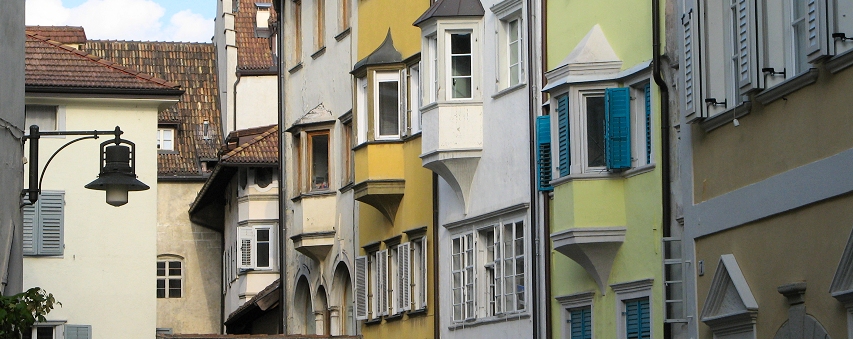
Facade in old town Bolzano.
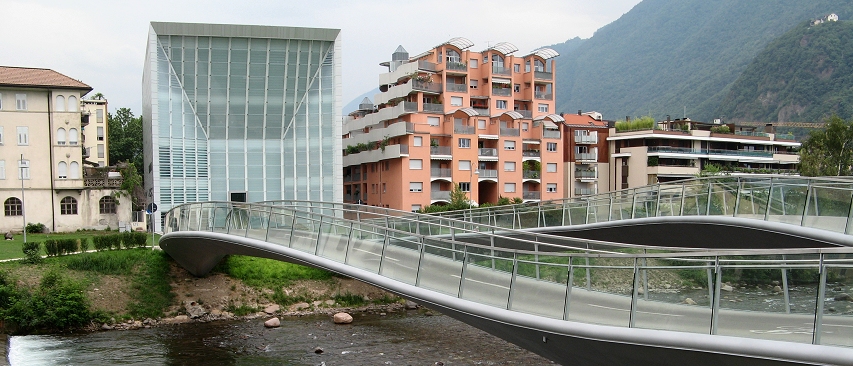
The Museion, Bolzano’s modern and contemporary art museum, and two bridges over the Talfer River.

The Rosengarten as seen from Bolzano.

More Hikes in the Dolomites of Italy Slide Show
More Hikes in the Dolomites of Italy Slide Show for iPad and iPhone

Photos on this page are by John Osaki (© All Rights Reserved) except as otherwise credited.


